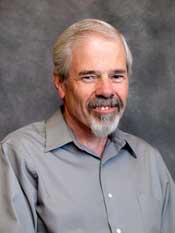CBE Students and Faculty Design Algae to Biofuel Process
 |
|
Dr. T. Gordon Smith
|
According to the U.S. Department of Energy, 40% of America's total energy needs, including 99% of the fuel used in our vehicles, are met by petroleum. With depleting fossil fuels and a warming climate, researchers at Colorado State University aren't depending on diminishing oil reserves to service our mounting energy needs, but rather growing their own. Engineering students and faculty are designing a process to economically farm algae and then convert the aquatic plants into biofuel.
A gold mine of oils, algae are rich in lipids required to create clean burning biodiesel. Working in conjunction with Dr. Bryan Willson, interim director of Colorado State's Clean Energy Supercluster, Gordon Smith, who teaches in the Department of Chemical and Biological Engineering (CBE), is investigating the key chemical reactions essential to the conversion process. Under the direction of Dr. Smith, CBE senior design students, whose poster took first place last April at the 2007 CSU BioFuels Research Colloquium, have been hard at work addressing not only reaction challenges, but also the utilization of process byproducts.
The first-of-its-kind process design has been created which incorporates lipid and biodiesel research from Indonesia and Tawain with work done at CSU and Solix Biofuels. Conducted in situ in a series of reactors at 60-70C and 1-2 atm, the proprietary process would convert algae to biodiesel under relatively mild conditions.
A byproduct, glycerol, is also formed during conversion. Biomolecular researchers at Rice University in Houston, Texas, have recently found a way to genetically engineer an E.coli capable of fermenting the glycerol into ethanol, yet another biofuel which is currently being produced in corn to ethanol plants. Based on Rice University research, a process was designed to make use of all the glycerol that would be generated in large-scale continuous algae to biodiesel facilities.
A novel innovation, algal biodiesel would reduce U.S. dependency on foreign oil. Currently, soybeans serve as the main feed stock in Colorado for biofuel production, but are also a food source and require much more water to grow than algae. Algae, on the other hand, could emerge as a cost-effective and efficient alternative to not only soybeans, but also other lipid containing edible plants.
Since algae are grown in contained reactors, the little water used to support algal communities could be recycled and reused. As well, algal cell matter waste from the process could be burned to produce enough energy to supply steam and electricity for the overall process, with any excess energy sold. Further, it may be possible to convert some of the cell matter to valuable chemicals.
The algae bioreactors are now under development at the CSU Engines and Energy laboratory where Dr. Willson is the director and at Solix Biofuels, a CSU spinoff company whose mission is to commercialize the growing of algae and its subsequent conversion to biodiesel. Dr. Smith and chemical engineer Mark Machacek of Solix have submitted a provisional patent disclosure for the continuous algae to biodiesel process design.
The next phase of research will include gathering data to add support to the patent's claims and to improve the design basis. During the upcoming year, a multidisciplinary group of senior design students from the CBE and mechanical engineering departments will be addressing those issues as well as estimating production costs of growing algae as a viable fuel source.
For more information on Solix Biofuels and the algae to biofuel process please visit http://www.solixbiofuels.com/